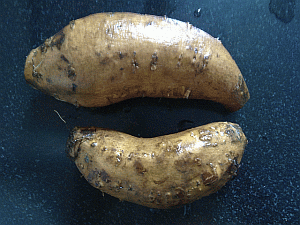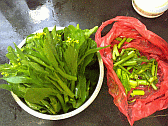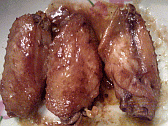|
|
| Fruit,
Vegetables and Gourds |
Fan Shei
or Chinese Sweet Yam |
|
Fan Shei or Chinese sweet yam is a common
vegetable in Canton and is available virtually all year
round. It is the tuber of a plant harvested when it
is 4-inches or longer.
Fan Shei also share similar proportions with
potatoes and other yams, being tubular in shape,
often with a slight curve.
They actually look and taste like a Suede on the
inside. Cooking is also similar, so you could
use them as a suede substitute in many dishes.
That stated, they are most often eaten whole after
cooking. You will see pictured left one my wife
was peeling and eating. There is a thin inner
skin which can be eaten or removed to your preference.
Cooking
The basic way to cook these is to wash them and
place in a plain saucepan of water and boil for
at least 20 minutes. Larger ones will obviously
require longer cooking time.
Recipe 1
Sliced Fan Shei
Taking half a pound of yams, peel and slice them
into pieces up to 1/4 inch thick. Add some water
to a pan or wok, add the Fan Shei, bring to the
boil and simmer for ten minutes or longer. Stir
occasionally and ensure there there is always
water in the pot. Chinese would normally stir
these and slightly overcook them, thus encouraging
a natural sauce to form. The dish is served with
this juice being poured over the top.
This is not a dish which easily lends itself to
adding other ingredients, but one such is lengths
of celery, which require a similar cooking time.
|


|
|
|
Recipe 2
Fan Shei Soup
This is virtually the same recipe as above, except you
are cutting the yams into various sized chunks and cooking
to serve a soup instead. It can be viewed as an alternative
to Pumpkin or Mango Soup, both of which can be cooked
in exactly the same way.
This dish is best made in a Chinese Soup Pot (See Utensils
for information) or large saucepan. We would usually
start with a pound of yams, but whatever quantity you
use, know that you cover these with water and then add
half as much water again. Bring to the boil and reduce
to a simmer, leave for about 1-hour, checking and stirring
occasionally.
Chinese would normally serve this to table in the soup
pot as is, by which time there should be a reasonably
thick and natural sauce. Whilst this is fine, it can
get a bit boring after a bowl full, so what can we do?
Again, adding celery chunks initially works very well,
as does adding a colourful array of capsicum peppers
ten minutes before serving. However, to make this quite
special we usually add see-through slivers of sour orange
or grapefruit half way through cooking, which I call
'orlimons'. |
|
Recipe 3
Fan Shei and Fa Hin (Chinese Cockles)
This is an unusual dish is similar to
other Cantonese Cockle recipes. I remain
unconvinced it would appear on any international
menu, but that's as may be.
Ingredients:
A splash of cooking oil (1 teaspoon).
1 small and very nasty chilli.
An inch of finely diced fresh wet ginger
root.
1 Chinese garlic.
Fan Shei cut into chunks.
1 teaspoon of chicken bouillon
1 rice bowl (or more) of water. I'm not
quite sure how big this is, but 1 gill should
about do it. |
 |
Cooking Method:
Into the wok with a smidgeon of oil, throw in
the sliced ginger and diced chilli. Toss for 30
seconds. Add the Fan Shei and continue to toss
for a couple of minutes. Throw in the crushed
Chinese garlic, and continue to toss for a further
minute. Add the dry chicken bouillon granules,
and keep tossing. You may be feeling tossed-off
by now, so add a little water and mix thoroughly
for 10 seconds. Add the rest of the water and
bring back to a simmer. Cover and wait for 5-minutes
before deciding to add a little more water and
about a pound of washed, fresh cockles - I'm not
sure why, but this is what my wife did. Re-cover
and leave to simmer for at least 15 minutes.
The dish is cooked once all the cockles have opened,
and it is then served as one dish of solids, and
a separate dish of murky orange liquid, or 'soup
'as my wife calls it.
I personally hope she never bothers to cook this
dish ever again, but I present this recipe because
it is very different by virtually all worldwide
culinary standards, and because it can be cooked
in UK.
|
|
|
|
|
This information is as supplied by ourselves, and ably
supported by our friends and various internet portals. |
|
| Search
this Website |
|
|
| Descriptions |









|
| Chinese Recipes |



|
|